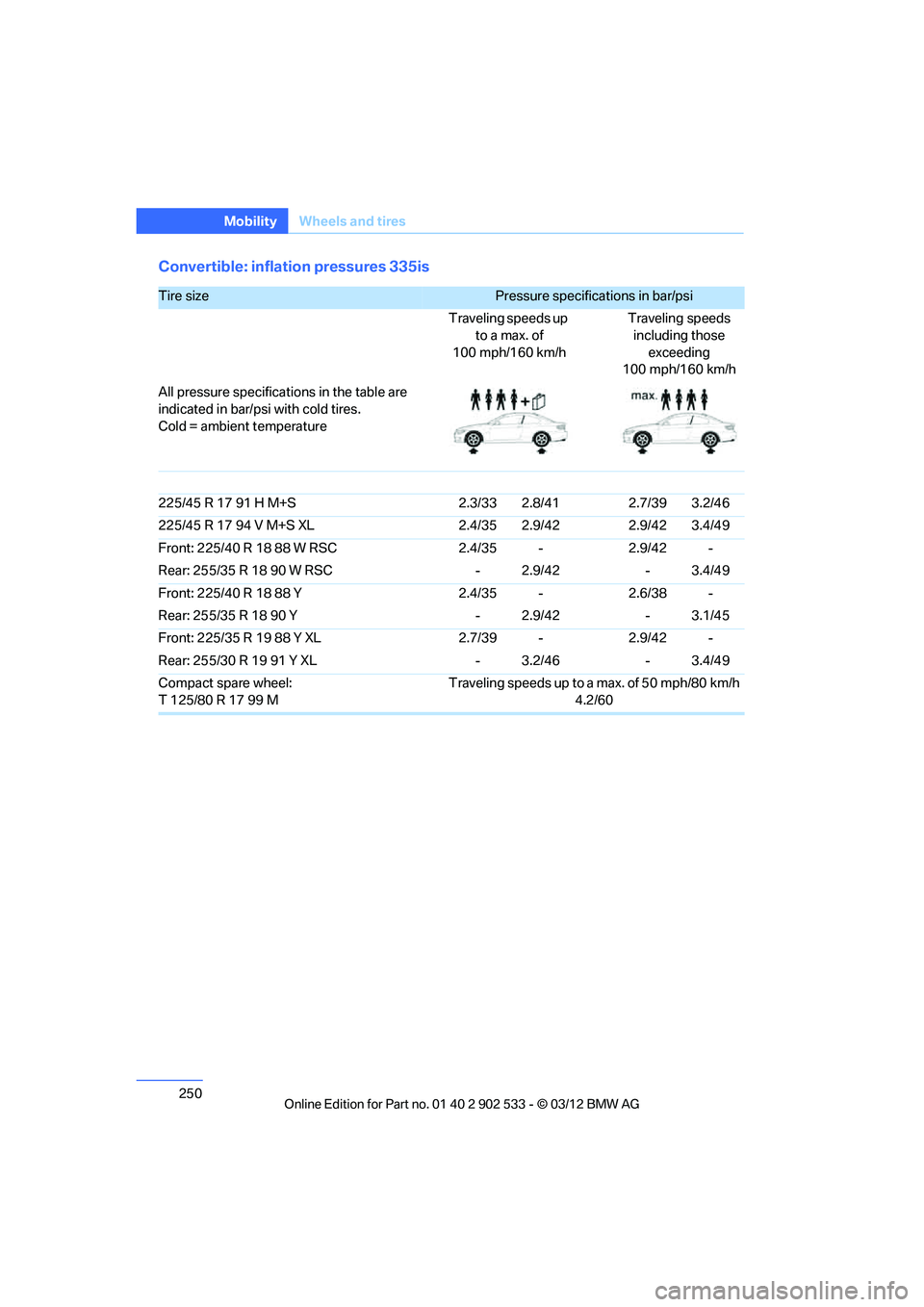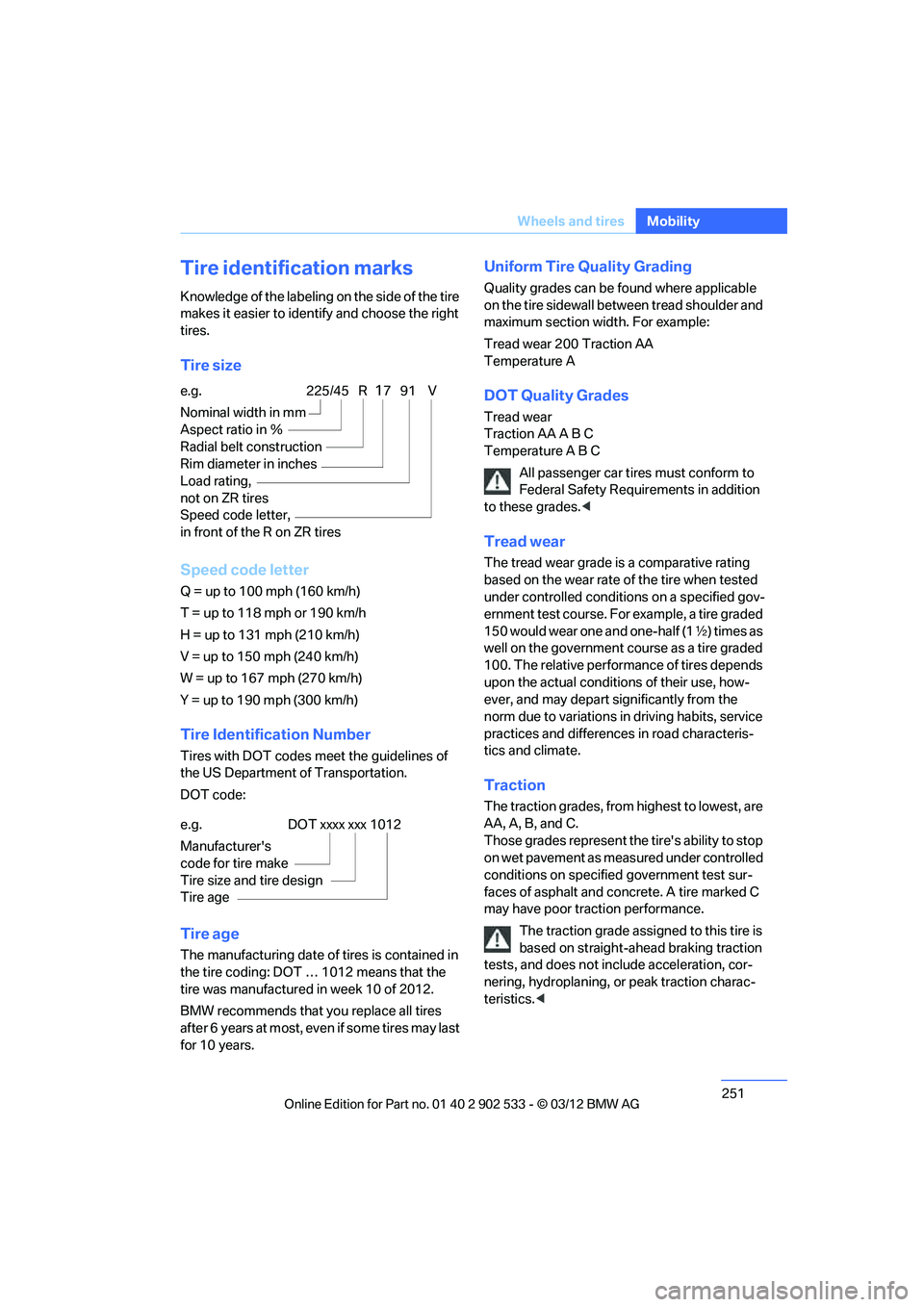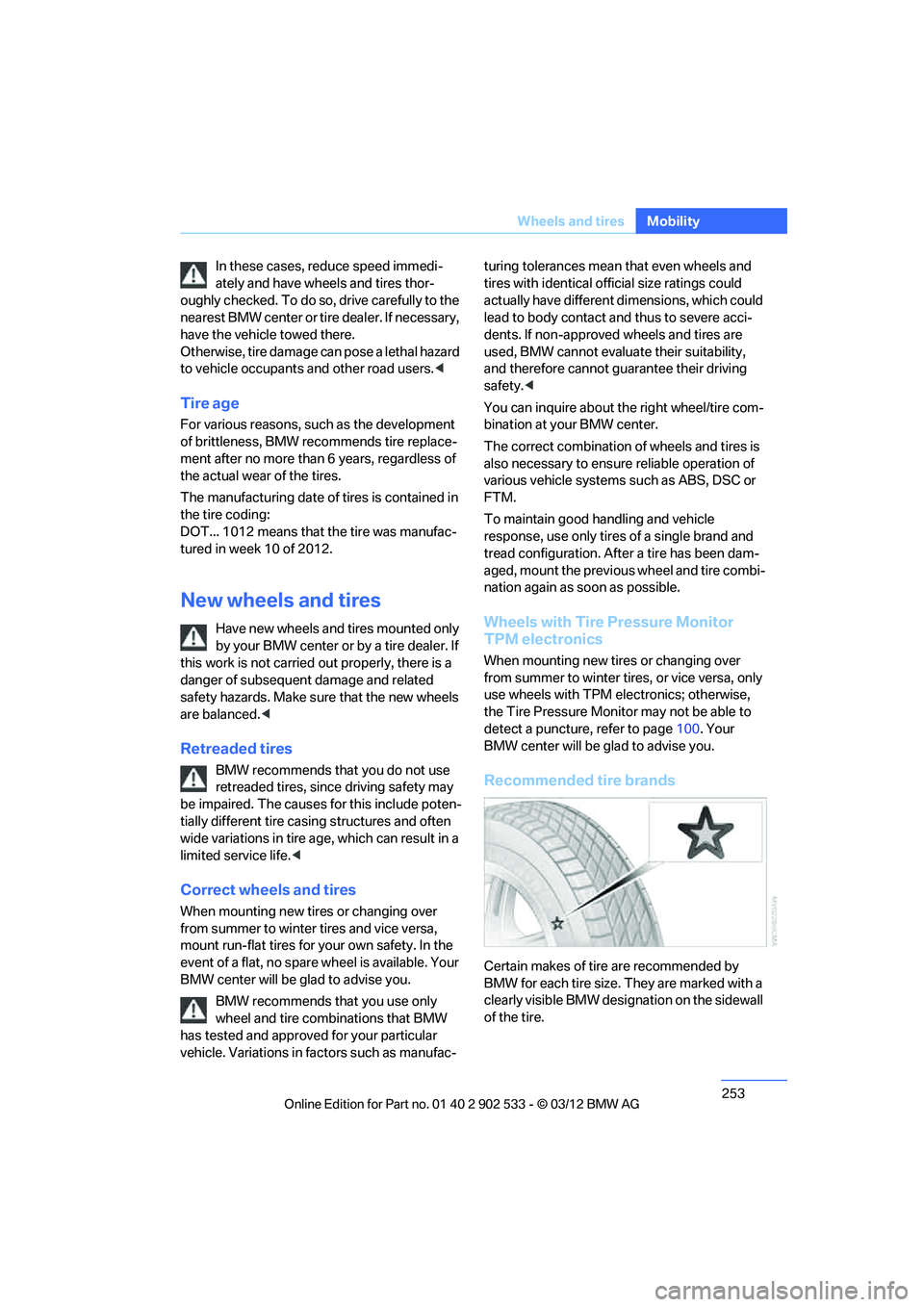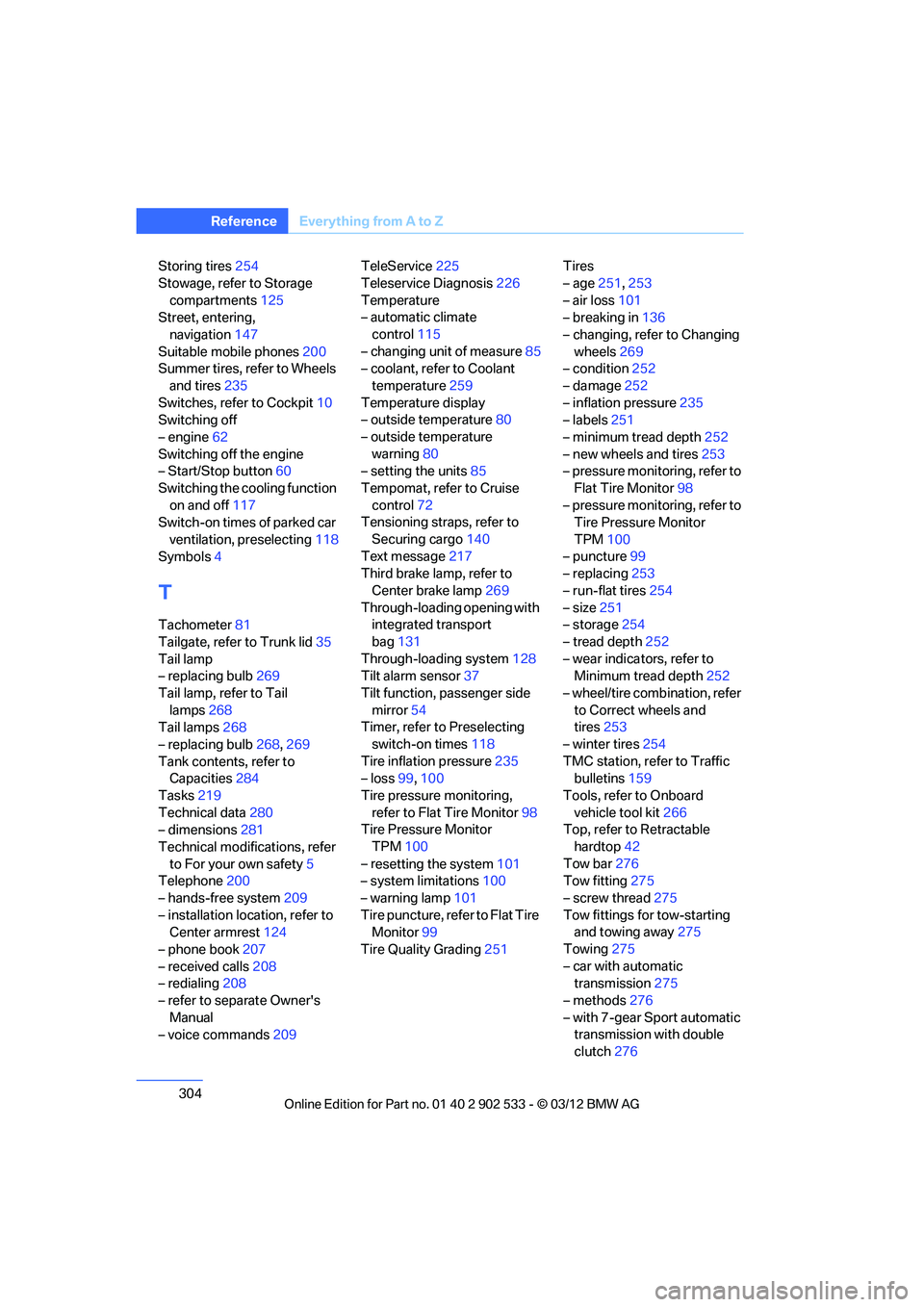2013 BMW 335I CONVERTIBLE wheel size
[x] Cancel search: wheel sizePage 251 of 308

250
MobilityWheels and tires
Convertible: inflation pressures 335is
Tire size Pressure specifications in bar/psi
Traveling speeds up to a max. of
100 mph/160 km/h Traveling speeds
including those exceeding
100 mph/160 km/h
All pressure specifications in the table are
indicated in bar/psi with cold tires.
Cold = ambient temperature
225/45 R 17 91 H M+S 2.3/33 2.8/41 2.7/39 3.2/46
225/45 R 17 94 V M+S XL 2.4/35 2.9/42 2.9/42 3.4/49
Front: 225/40 R 18 88 W RSC 2.4/35 - 2.9/42 -
Rear: 255/35 R 18 90 W RSC - 2.9/42 - 3.4/49
Front: 225/40 R 18 88 Y 2.4/35 - 2.6/38 -
Rear: 255/35 R 18 90 Y - 2.9/42 - 3.1/45
Front: 225/35 R 19 88 Y XL 2.7/39 - 2.9/42 -
Rear: 255/30 R 19 91 Y XL - 3.2/46 - 3.4/49
Compact spare wheel:
T 125/80 R 17 99 M Traveling speeds up to a max. of 50 mph/80 km/h
4.2/60
00320051004F004C00510048000300280047004C0057004C005200510003
Page 252 of 308

251
Wheels and tires
Mobility
Tire identification marks
Knowledge of the labeling on the side of the tire
makes it easier to identify and choose the right
tires.
Tire size
Speed code letter
Q = up to 100 mph (160 km/h)
T = up to 118 mph or 190 km/h
H = up to 131 mph (210 km/h)
V = up to 150 mph (240 km/h)
W = up to 167 mph (270 km/h)
Y = up to 190 mph (300 km/h)
Tire Identification Number
Tires with DOT codes meet the guidelines of
the US Department of Transportation.
DOT code:
Tire age
The manufacturing date of tires is contained in
the tire coding: DOT … 1012 means that the
tire was manufactured in week 10 of 2012.
BMW recommends that you replace all tires
after 6 years at most, even if some tires may last
for 10 years.
Uniform Tire Quality Grading
Quality grades can be found where applicable
on the tire sidewall between tread shoulder and
maximum section width. For example:
Tread wear 200 Traction AA
Temperature A
DOT Quality Grades
Tread wear
Traction AA A B C
Temperature A B C
All passenger car tires must conform to
Federal Safety Requirements in addition
to these grades. <
Tread wear
The tread wear grade is a comparative rating
based on the wear rate of the tire when tested
under controlled conditions on a specified gov-
ernment test course. For example, a tire graded
150 would wear one and one-half (1 γ) times as
well on the government course as a tire graded
100. The relative performance of tires depends
upon the actual conditions of their use, how-
ever, and may depart significantly from the
norm due to variations in driving habits, service
practices and differences in road characteris-
tics and climate.
Traction
The traction grades, from highest to lowest, are
AA, A, B, and C.
Those grades represent the tire's ability to stop
on wet pavement as measured under controlled
conditions on specified government test sur-
faces of asphalt and concrete. A tire marked C
may have poor traction performance.
The traction grade assigned to this tire is
based on straight-ahead braking traction
tests, and does not include acceleration, cor-
nering, hydroplaning, or peak traction charac-
teristics. <
e.g.
Nominal width in mm
Aspect ratio in
Ξ
Radial belt construction
Rim diameter in inches
Load rating,
not on ZR tires
Speed code letter,
in front of the R on ZR tires
225/45 R1791 V
e.g.
Manufacturer's
code for tire make
Tire size and tire design
Tire ageDOT xxxx xxx 1012
00320051004F004C00510048000300280047004C0057004C005200510003
Page 254 of 308

253
Wheels and tires
Mobility
In these cases, reduce speed immedi-
ately and have wheels and tires thor-
oughly checked. To do so, drive carefully to the
nearest BMW center or tire dealer. If necessary,
have the vehicle towed there.
Otherwise, tire damage can pose a lethal hazard
to vehicle occupants and other road users. <
Tire age
For various reasons, such as the development
of brittleness, BMW recommends tire replace-
ment after no more than 6 years, regardless of
the actual wear of the tires.
The manufacturing date of tires is contained in
the tire coding:
DOT... 1012 means that the tire was manufac-
tured in week 10 of 2012.
New wheels and tires
Have new wheels and tires mounted only
by your BMW center or by a tire dealer. If
this work is not carried out properly, there is a
danger of subsequent damage and related
safety hazards. Make sure that the new wheels
are balanced. <
Retreaded tires
BMW recommends that you do not use
retreaded tires, since driving safety may
be impaired. The causes for this include poten-
tially different tire casing structures and often
wide variations in tire age, which can result in a
limited service life. <
Correct wheels and tires
When mounting new tires or changing over
from summer to winter tires and vice versa,
mount run-flat tires for your own safety. In the
event of a flat, no spare wheel is available. Your
BMW center will be glad to advise you.
BMW recommends that you use only
wheel and tire combinations that BMW
has tested and approved for your particular
vehicle. Variations in factors such as manufac- turing tolerances mean that even wheels and
tires with identical official size ratings could
actually have different dimensions, which could
lead to body contact and thus to severe acci-
dents. If non-approved wheels and tires are
used, BMW cannot evaluate their suitability,
and therefore cannot guarantee their driving
safety.<
You can inquire about the right wheel/tire com-
bination at your BMW center.
The correct combination of wheels and tires is
also necessary to ensure reliable operation of
various vehicle systems such as ABS, DSC or
FTM.
To maintain good handling and vehicle
response, use only tires of a single brand and
tread configuration. After a tire has been dam-
aged, mount the previous wheel and tire combi-
nation again as soon as possible.
Wheels with Tire Pressure Monitor
TPM electronics
When mounting new tires or changing over
from summer to winter tire
s, or vice versa, only
use wheels with TPM electronics; otherwise,
the Tire Pressure Monitor may not be able to
detect a puncture, refer to page 100. Your
BMW center will be glad to advise you.
Recommended tire brands
Certain makes of tire are recommended by
BMW for each tire size. They are marked with a
clearly visible BMW designation on the sidewall
of the tire.
00320051004F004C00510048000300280047004C0057004C005200510003
Page 255 of 308

254
MobilityWheels and tires
When properly used, these tires meet the high-
est standards in terms of safety and handling
characteristics.
Special characteristics of winter tires
BMW recommends winter tires for driving on
winter roads or at temperatures below +45 7/
+7 6. Although all-season M+S tires provide
better winter traction than summer tires, they
generally fail to provide the same levels of cold-
weather performance as winter tires.
Pay attention to speed
Always comply with the speed limit for the
winter tires mounted on your car; failure
to do so could result in tire damage and acci-
dents. <
If the car is capable of speeds higher than that
permitted for the winter tires, a label stating the
maximum permitted speed for the mounted
tires must be displayed in your field of view.
Specialist tire dealers and your BMW center
can supply these labels.
Storage
Always store wheels and tires in a cool, dry
place with as little exposure to light as possible.
Always protect tires against all contact with oil,
grease and fuels. Do not exceed the maximum
tire inflation pressure indicated on the sidewall
of the tire.
Swapping wheels between axles
BMW advises against swapping wheels
between the front and rear axles, even if all tires
have the same size, as this could impair driving
characteristics. If the tires are of mixed sizes,
swapping wheels between the axles is not per-
missible.
Run-flat tires
The symbol identifying run-flat tires is a circle
with the letters RSC on the sidewall.
Run-flat tires comprise a conditionally self-sup-
porting tire and a special rim. The reinforce-
ment in the sidewalls ensures that the tire can
continue to be used subject to certain restric-
tions, even if depressurized.
For information on continuing to drive with a flat
tire, refer to Indication of a flat tire, page 99.
Snow chains
Only certain fine-link snow chains have been
tested by BMW, classified as safe for use and
recommended. Consult your BMW center for
more information.
Snow chains must be mounted in pairs and on
the rear wheels only. Observe the manufac-
turer's instructions when mounting snow
chains. Do not exceed a speed of 30 mph or
50 km/h.
Do not initialize the Flat Tire Monitor if
snow chains are mounted; otherwise, the
instrument might issue an incorrect reading.
When driving with snow chains, you may find it
helpful to activate DTC temporarily, refer to
page 96.<
00320051004F004C00510048000300280047004C0057004C005200510003
Page 305 of 308

304
Referen ceEverything from A to Z
Storing tires254
Stowage, refer to Storage compartments 125
Street, entering,
navigation 147
Suitable mobile phones 200
Summer tires, refer to Wheels
and tires 235
Switches, refer to Cockpit 10
Switching off
– engine 62
Switching off the engine
– Start/Stop button 60
Switching the cooling function on and off 117
Switch-on times of parked car
ventilation, preselecting 118
Symbols 4
T
Tachometer 81
Tailgate, refer to Trunk lid 35
Tail lamp
– replacing bulb 269
Tail lamp, refer to Tail lamps 268
Tail lamps 268
– replacing bulb 268,269
Tank contents, refer to Capacities 284
Tasks 219
Technical data 280
– dimensions 281
Technical modifications, refer to For your own safety 5
Telephone 200
– hands-free system 209
– installation location, refer to Center armrest 124
– phone book 207
– received calls 208
– redialing 208
– refer to separate Owner's Manual
– voice commands 209TeleService
225
Teleservice Diagnosis 226
Temperature
– automatic climate control 115
– changing unit of measure 85
– coolant, refer to Coolant
temperature 259
Temperature display
– outside temperature 80
– outside temperature warning 80
– setting the units 85
Tempomat, refer to Cruise control 72
Tensioning straps, refer to
Securing cargo 140
Text message 217
Third brake lamp, refer to
Center brake lamp 269
Through-loading opening with integrated transport
bag 131
Through-loading system 128
Tilt alarm sensor 37
Tilt function, passenger side mirror 54
Timer, refer to Preselecting
switch-on times 118
Tire inflation pressure 235
– loss 99,100
Tire pressure monitoring, refer to Flat Tire Monitor 98
Tire Pressure Monitor
TPM 100
– r es
etting the system 101
– system limitations 100
– warning lamp 101
Tire puncture, refer to Flat Tire Monitor 99
Tire Quality Grading 251Tires
– age
251,253
– air loss 101
– breaking in 136
– changing, refer to Changing wheels 269
– condition 252
– damage 252
– inflation pressure 235
– labels 251
– minimum tread depth 252
– new wheels and tires 253
– pressure monitoring, refer to
Flat Tire Monitor 98
– pressure monitoring, refer to Tire Pressure Monitor
TPM 100
– puncture 99
– replacing 253
– run-flat tires 254
– size 251
– storage 254
– tread depth 252
– wear indicators, refer to Minimum tread depth 252
– wheel/tire combination, refer to Correct wheels and
tires 253
– winter tires 254
TMC station, refer to Traffic bulletins 159
Tools, refer to Onboard vehicle tool kit 266
Top, refer to Retractable
hardtop 42
Tow bar 276
Tow fitting 275
– screw thread 275
Tow fittings for tow-starting and towing away 275
Towing 275
– car with automatic transmission 275
– methods 276
– with 7-gear Sport automatic transmission with double
clutch 276
00320051004F004C00510048000300280047004C0057004C005200510003